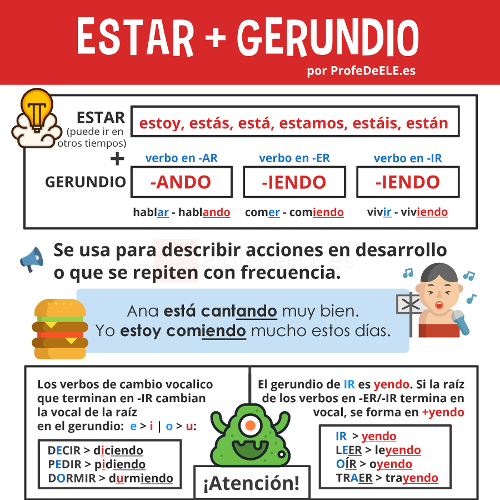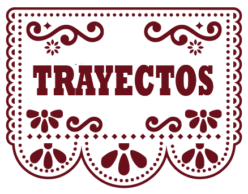Uses of “estar” and the present progressive: Uso y forma
![]() ¿Dónde están?
¿Dónde están?
Paso 1. Desde el comienzo de nuestro trayecto, usamos el verbo estar. ¿Cuándo usamos este verbo? ¿Qué ideas expresamos? Piensa en dos ejemplos diferentes.
Paso 2. Ahora escucha el diálogo a continuación. Edwin and Allison are meeting up at a restaurant for a surprise birthday party for Víctor. Pay attention to the verb estar. What uses are similar to the ones you described and which ones are different? Hypothesize on other uses of this very common verb.
Aimar: Edwin: Aimar: 
¿Comprendiste? Completa estas actividades sobre el diálogo.
-
- Let’s talk about the verb estar first. See if you can find an example of the following in the conversation
- This verb is used to express location and emotion.
- This verb is used to express an action in progress. What is estar followed by when we talk about an action in progress?
- Let’s talk about the verb estar first. See if you can find an example of the following in the conversation
How do we conjugate this verb? What are the forms that appear in the dialogue? Usa el cuadro a continuación to conjugate this verb.
| yo | nosotros |
| tú
vos |
vosotros |
| él/ella/usted | ellos/ellas/ustedes |
2. Now let’s talk about the content of the dialogue (continue paying attention to the verb forms).
-
- ¿Dónde están todos?
- ¿Qué están haciendo? ¿Por qué?
- ¿Cómo están los amigos? ¿Qué quieren ver?
Hablamos de “estar”
As you have seen, the verb estar is used to refer to different ideas. One of the ways in which you can remember how to use the verb is by remembering the acronym P.L.A.C.E. Let’s go over each of the ways in which you use estar.
Position:
Los platos están arriba.
Los amigos de Víctor están a la derecha (right) de la mesa.
Location:
La fruta está en la mesa.
Estamos en la clase de español.
Condition:
(Yo) estoy cansada.
¿Estás enfermo (sick)?
Emotion:
¿Vosotros estáis tristes por la derrota (defeat) del equipo de fútbol?
Los amigos de Víctor están nerviosos.
Actions in progress: The present progressive
Estar is combined with the present participle of a verb (the stem of a verb plus -ando [for -ar verbs; e.g., caminando] or -endo/-iendo [for -er and -ir verbs; e.g., yendo (present participle of ir), comiendo; escribiendo]) to refer to actions that are in progress at the moment when the person is speaking (e.g., Estamos estudiando los usos del verbo estar.).
estudiar –> estudiando ir –> yendo vender –> vendiendo abrir –> abriendo
Aimar está estudiando.
Edwin está yendo a clase.
Juan y yo estamos vendiendo las frutas.
¿(Vos) estás abriendo la tienda? ¿Dónde está José? Él debe abrir la tienda hoy.
![]() ¡Ojo!
¡Ojo!
Present Progressive vs. Simple Present
Just like English, Spanish uses the present progressive tense to describe actions that are occurring while one is speaking (e.g., John is writing a letter). Also similar to English, the present tense is used to describe actions that one does repeatedly or habitually (e.g., John writes a letter every morning). One difference between the two languages, however, is that in Spanish the present tense can also be used to describe progressive actions. For example:
| ¿Qué haces? / ¿Qué estás haciendo? | What are you doing? |
| ¿Qué escuchas/ ¿Qué estás escuchando? | What are you listening to? |
Attribution: Spanish Proficiency Exercises by COERLL, licensed under CC BY.
Ahora mira el siguiente vídeo. It offers a summary of the verb estar and its uses.
![]() El verbo estar
El verbo estar
Attribution: By Cyber Profe, licensed under CC BY 4.0.
Ahora vamos a usar el verbo estar. Vamos a Actividad 2-14. Estar + gerundio. Visita la página en https://bit.ly/GerundTrayectos. Paso 1. Use the following image to review the uses of the present progressive. Paso 2. En la misma página (https://bit.ly/GerundTrayectos), completa las actividades 1, 2, 3 y 4. Be ready to discuss your results with other classmates. Attribution: By BancoGalicia, licensed under CC BY-SA 4.0. Paso 1. Completa el siguiente cuadro con la información del vídeo. ![]() ¡Manos a la obra!
¡Manos a la obra!

![]() Actividad 2-15. ¿Dónde está mamá? Mira el siguiente video. ¿Qué está pasando en la familia?
Actividad 2-15. ¿Dónde está mamá? Mira el siguiente video. ¿Qué está pasando en la familia?
Integrantes de la familia
Al comienzo del video:
¿Dónde están el papá y la bebé?
¿Qué están haciendo?
¿Dónde está la mamá?
¿Qué está haciendo?
Describe las emociones del papá y la mamá.
Al final del video:
¿Dónde están el papá y la bebé?
¿Qué están haciendo?
¿Dónde está la mamá?
¿Qué está haciendo?
Describe las emociones del papá y la mamá.
![]() Paso 2. Con un@ compañer@, analiza el contenido del vídeo.
Paso 2. Con un@ compañer@, analiza el contenido del vídeo.
Click on the following button to continue using your new vocabulary and structures.
Ahora vamos a aprender más sobre el país de Aimar. Vamos a


